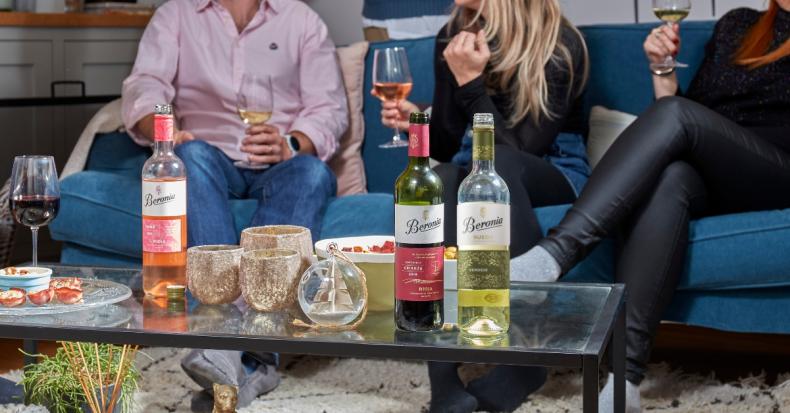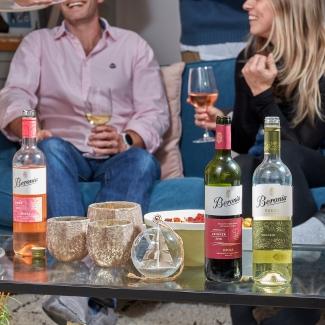What is the difference between white, rosé, and red wines apart from the colour? This is a question wine experts get asked a lot, and as Beronia produces white, rosé (rosado) and red Rioja, it’s a question we’re well-placed to answer.
In this blog, we’ll look at what gives wines their colour (spoiler alert, it’s not always about the colour of the grape!) and the typical characteristics of white, rosé, and red wines.
White Wines
The first thing to say about white wines is that they aren’t always made using white grapes. With a few exceptions – Spain’s Alicante Bouschet, for example – most grapes, regardless of their skin colour, give clear, green-white coloured juice. This means you can make white wine from pretty much any grape you like, which is why wines such as Cava contain juice from black grapes like Monastrell or Garnacha. The key thing is to not let the juice spend time in contact with the skins.
In the main, white wines are made to be fruity and for drinking at an early age. A great example is our Beronia Viura, which is packed with soft, white berry and melon fruit and is ideal served chilled with or without food.
Many of the world’s finest white wines are aged in oak – often American or French or a combination of the two. With creamier-tasting grapes such as Viura, the oak adds an extra vanilla tone and, by allowing a little oxidation, softens it and adds depth.
Rosé Wines
Rosé – or rosado wines as they are known in Spain – can offer the refreshment of a white wine with some of the weight and intensity of a red. Take the Beronia Rosé Rioja. Fresh red berries and citrus combine with deeper, darker notes of cherries and almonds to give the best of both worlds.
In terms of winemaking, rosé wines can be made in one of four ways:
- Maceration – this involves gently pressing red grapes, such as Garnacha or Tempranillo, and then leaving the juice in contact with the skins so they turn the juice pink.
- Saignee or ‘bleeding’ – this is where you take juice that’s destined for red wine production and add it to the white juice. This is the hardest way to make a rosé, as controlling the colour and level of extract from the skins can be difficult to judge.
- Direct press – this is the technique that’s used to make red wines; black grapes are pressed, allowing colour to enter the juice. Before too much colour can be absorbed, however, the juice is removed, leaving a rosé tint.
- Blending – white wines are mixed with a splash of red to give the required shade of rosé.
Depending on the winemaker’s preference, rosé wines can range from light, strawberry-flavoured, fun-filled affairs to altogether more serious, fine wines like the Alegra de Beronia. The Alegra is a wine that can partner with everything from hot smoked salmon to spring lamb.
While some rosé wines receive oak ageing, it’s far from the norm. In most cases, rosé wine’s great joy comes from its abundant fruit and freshness that wood could mask.
Red Wines
Red wines are the standard bearer for many of the world’s wine regions. Red Rioja is fit to rank with the finest wines, with the best examples offering exceptional complexity and an almost endless lifespan.
In terms of winemaking, the direct press method mentioned above is the most popular. Grapes are pressed and then left in contact with their skins so that colour and other elements such as tannins – compounds found in skins, seeds, and stems that add structure – leach out.
If the skins are left to their own devices, they will float to the surface, forming a cap, and sufficient colour may not be extracted. For this reason, the juice, or ‘must’, is often continually pumped over the skins to produce the vivid, deep colour wine lovers expect.
Like rosé and white wines, red wines can be fermented in open cement vats, stainless vats, ceramic eggs, or large wooden casks. Once the wines are ready, the best are aged in new oak barrels. Oak ageing is a fundamental part of producing the finest red Riojas, and wines such as the Beronia Reserva and Beronia Gran Reserva can spend as much as two years slowly developing in small barrels. During this time, they absorb a lovely buttery edge and, if aged in American oak, a distinctly spicy tone too.
Thanks to their makeup, red wines can age for many, many years. Rioja is well-known for its ageing capacity, and wines can be magnificent fifty years after they were produced. The vast majority will be ready to drink when released, though. Opening them in advance and letting them breathe allows oxygen to react with the wine, which helps soften it and brings out its finer qualities.
Red wines are often better with food when young. Their power, weight of fruit, and freshness help them to simultaneously cut through food’s flavours and enhance them. As they age, the tannins subside, the tones mellow, and ‘secondary’ flavours emerge – anything from woodland berries to dried rose petals – they become wonderful solo sippers. Try the Beronia Gran Reserva 2015, and you’ll see what we mean!
Like to Know More About Rioja?
We hope this guide to white, rosé and red wines has been interesting. If you’d like to know more about the wines of Rioja, from which foods to pair with them to finding out what makes the region’s wines unique, you can keep exploring via the Beronia Rioja blog.




